Testing the Pumper
Last Sunday morning Glenn and I drove the pumper twenty miles over to the Athens-Clarke County Fire Training Facility. That in itself was something of a challenge - our pumper is of 1987 vintage. Though 1987 was a good year, and though it has automatic transmission and power brakes and steering, it's still a large unwieldy truck carrying four tons of water. Here we are, below, all hooked up. In the background you'll see the 4-storey burn building at the Facility. Foreground is the swimming pool where the water for the tests is kept.
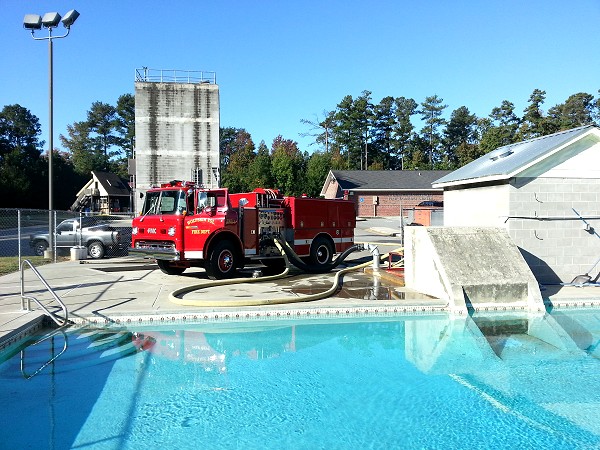 Our pumper, which has an FMC body and a Caterpillar engine, needed its annual pump test, which is a requirement if you'd like, say, to get community insurance rates down. One big six-inch hose suctions water out of the pool (that's also part of the test - priming), and the truck delivered pumped water through three 2-3/4-inch hoses, (yellow lines in the photo below). The water in the pumper tank is actually never used.
Our pumper, which has an FMC body and a Caterpillar engine, needed its annual pump test, which is a requirement if you'd like, say, to get community insurance rates down. One big six-inch hose suctions water out of the pool (that's also part of the test - priming), and the truck delivered pumped water through three 2-3/4-inch hoses, (yellow lines in the photo below). The water in the pumper tank is actually never used.
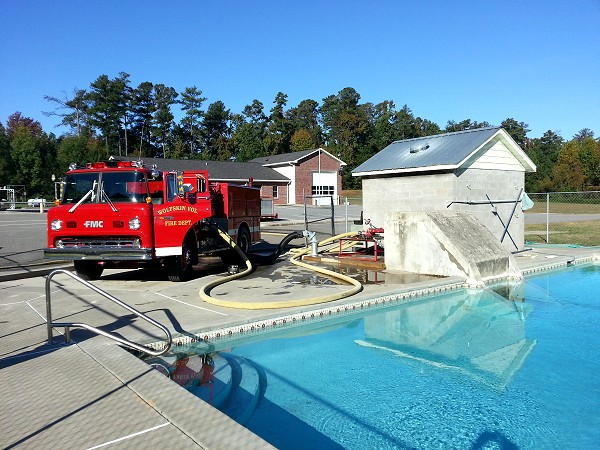 Above, you can see that the three hoses deliver water to a deck gun, which combines the streams and then measures the flow rate of the blast. The blast is directed to the concrete blast deflector, and back into the pond. The blast deflector is a little more obvious below.
Above, you can see that the three hoses deliver water to a deck gun, which combines the streams and then measures the flow rate of the blast. The blast is directed to the concrete blast deflector, and back into the pond. The blast deflector is a little more obvious below.
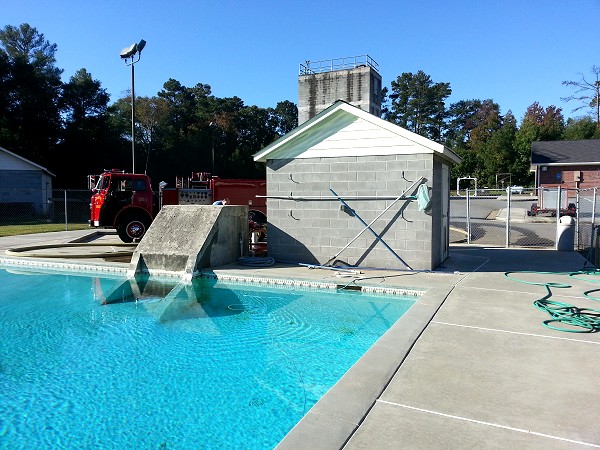 Here is a little detail that is important to what happened next: We operate the pump from the panel on the side of the truck, behind the driver's seat. There is a knob that you turn to change the rpms of the truck engine, which in turn operates the pump. That knob is hooked to the accelerator foot pedal through a cable.
So back to the tests. There are three major tests, which operate the pump far above levels we would normally use (it's very loud!). The first one is for 20 continuous minutes at 1000 gallons per minute at a pressure of 150 psi (we'd normally not go above 100 psi). The pumper passed that one, but failed to get up to the necessary 250 psi for the last test.
The fellow who was conducting the test said that he knew what might be the problem, and proved it by jumping into the cab and putting his foot on the accelerator. The pressure jumped up to the needed 250 psi. So the problem was the cable between the throttle control on the panel and the accelerator foot pedal. He popped the cab, tweaked the cable, and the pumper passed the tests with no problem.
(He told us how to fix it permanently, and we did that at our regular training session on Thursday night. He also advised us that popping the cab is a lot easier with the doors open, and putting it back down is a lot easier with the doors closed.)
Glenn and I walked around the facility. Here's the main building and on the left is the burn building I mentioned earlier.
Here is a little detail that is important to what happened next: We operate the pump from the panel on the side of the truck, behind the driver's seat. There is a knob that you turn to change the rpms of the truck engine, which in turn operates the pump. That knob is hooked to the accelerator foot pedal through a cable.
So back to the tests. There are three major tests, which operate the pump far above levels we would normally use (it's very loud!). The first one is for 20 continuous minutes at 1000 gallons per minute at a pressure of 150 psi (we'd normally not go above 100 psi). The pumper passed that one, but failed to get up to the necessary 250 psi for the last test.
The fellow who was conducting the test said that he knew what might be the problem, and proved it by jumping into the cab and putting his foot on the accelerator. The pressure jumped up to the needed 250 psi. So the problem was the cable between the throttle control on the panel and the accelerator foot pedal. He popped the cab, tweaked the cable, and the pumper passed the tests with no problem.
(He told us how to fix it permanently, and we did that at our regular training session on Thursday night. He also advised us that popping the cab is a lot easier with the doors open, and putting it back down is a lot easier with the doors closed.)
Glenn and I walked around the facility. Here's the main building and on the left is the burn building I mentioned earlier.
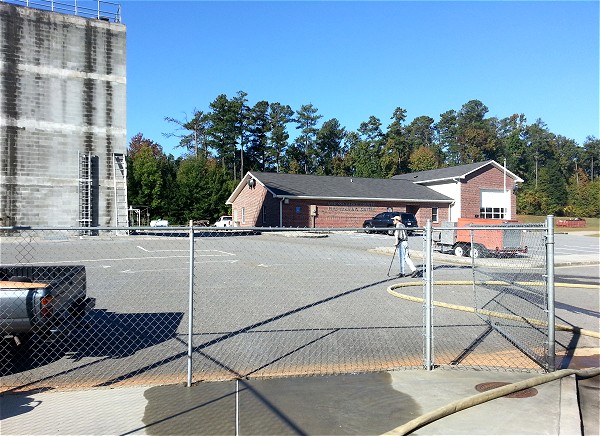 Here's the burn building from the other side, looking fairly well burned. Inside it's a torture chamber of rooms and stairs and such.
Here's the burn building from the other side, looking fairly well burned. Inside it's a torture chamber of rooms and stairs and such.
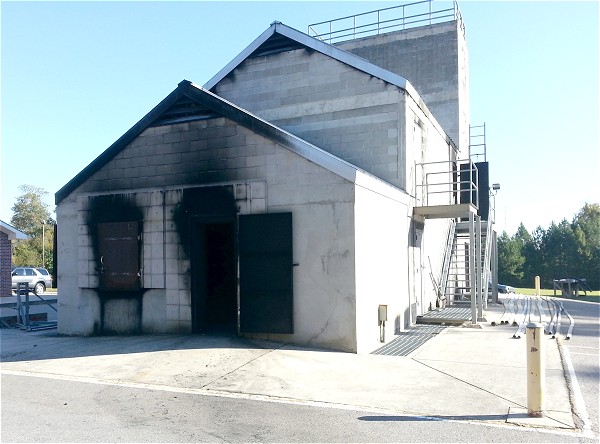 This is the close quarters obstacle course. It's fully opened on the left, but somewhere in the middle they put in a horizontal floor that partitions the space into two sections. Now that is *very* cramped.
This is the close quarters obstacle course. It's fully opened on the left, but somewhere in the middle they put in a horizontal floor that partitions the space into two sections. Now that is *very* cramped.
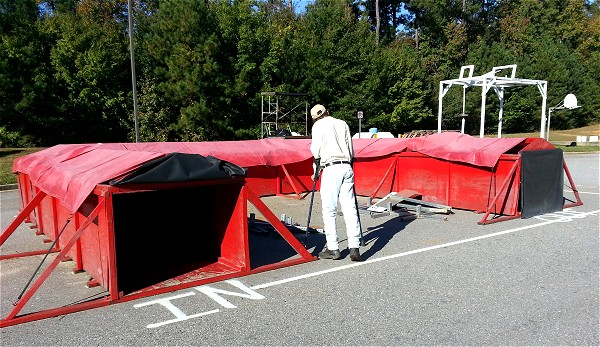 Finally, we have dead cars for rescue training.
Finally, we have dead cars for rescue training.
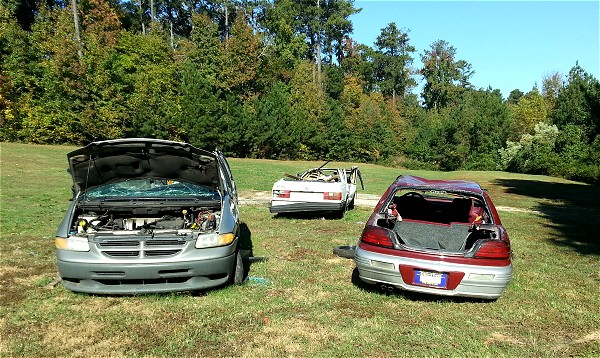 Thanks to the two guys from Oconee and A-CC who did the pump testing. They said they'd gone through twelve trucks on Friday and had it down to a science. Even as we backed out of the bay, the next truck from Winterville was pulling up, so they did indeed have things scheduled well.
And that was our late October Sunday.
Thanks to the two guys from Oconee and A-CC who did the pump testing. They said they'd gone through twelve trucks on Friday and had it down to a science. Even as we backed out of the bay, the next truck from Winterville was pulling up, so they did indeed have things scheduled well.
And that was our late October Sunday.


